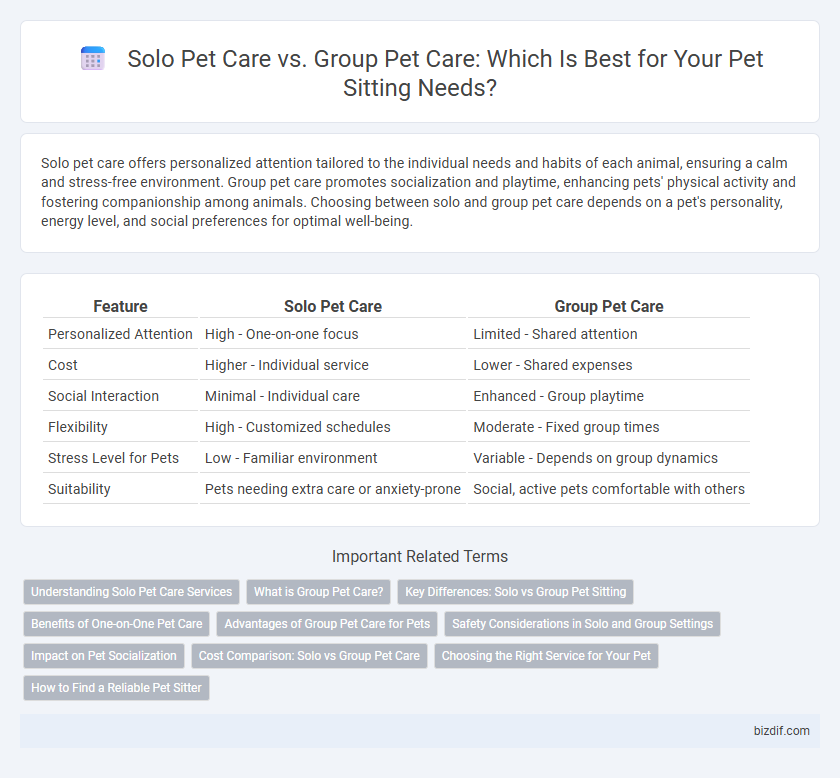Solo pet care offers personalized attention tailored to the individual needs and habits of each animal, ensuring a calm and stress-free environment. Group pet care promotes socialization and playtime, enhancing pets' physical activity and fostering companionship among animals. Choosing between solo and group pet care depends on a pet's personality, energy level, and social preferences for optimal well-being.
Table of Comparison
| Feature | Solo Pet Care | Group Pet Care |
|---|---|---|
| Personalized Attention | High - One-on-one focus | Limited - Shared attention |
| Cost | Higher - Individual service | Lower - Shared expenses |
| Social Interaction | Minimal - Individual care | Enhanced - Group playtime |
| Flexibility | High - Customized schedules | Moderate - Fixed group times |
| Stress Level for Pets | Low - Familiar environment | Variable - Depends on group dynamics |
| Suitability | Pets needing extra care or anxiety-prone | Social, active pets comfortable with others |
Understanding Solo Pet Care Services
Solo pet care services provide personalized attention tailored to each pet's unique needs, ensuring customized feeding, exercise, and medication schedules. This approach reduces stress for pets that thrive in quiet, one-on-one environments, improving overall well-being and behavior. Solo care also allows sitters to monitor health closely and respond promptly to any emergencies or changes in condition.
What is Group Pet Care?
Group pet care involves looking after multiple pets simultaneously, typically in a shared environment such as a home or daycare facility. This approach allows pets to socialize and engage in interactive play, which can enhance their mental and physical well-being. Group pet care requires careful supervision to ensure safety, prevent conflicts, and meet the individual needs of each animal.
Key Differences: Solo vs Group Pet Sitting
Solo pet care offers personalized attention tailored to the specific needs and routines of a single pet, ensuring focused care and minimizing stress for sensitive animals. Group pet care involves supervising multiple pets simultaneously, promoting socialization but requiring skilled management to prevent conflicts and ensure safety. Key differences include the level of individualized attention, the environment's social dynamics, and the sitter's ability to effectively monitor and respond to each animal's behavior.
Benefits of One-on-One Pet Care
One-on-one pet care ensures individualized attention, tailoring activities and feeding schedules to each pet's unique needs and temperament. Solo care minimizes stress and anxiety often triggered by group dynamics, fostering a calm and secure environment. Personalized care also allows pet sitters to closely monitor health changes, providing timely intervention and enhancing overall well-being.
Advantages of Group Pet Care for Pets
Group pet care offers significant socialization benefits, allowing pets to interact with others of similar age and energy levels, which promotes healthy behavioral development. The structured environment in group settings provides stimulation through play and exercise, reducing feelings of boredom and anxiety. Access to varied activities and continuous supervision in group care improves pets' overall well-being and helps prevent loneliness-related stress.
Safety Considerations in Solo and Group Settings
Solo pet care ensures individualized attention, reducing the risk of unnoticed health issues or behavioral problems. Group pet care requires careful monitoring to prevent aggression, stress, or the spread of contagious diseases among animals. Implementing strict safety protocols, including vaccination checks and supervised interactions, is essential in both settings to protect pets' well-being.
Impact on Pet Socialization
Solo pet care offers personalized attention tailored to an individual pet's needs, promoting stronger owner-pet bonds and reducing stress for shy or anxious animals. Group pet care encourages socialization by exposing pets to diverse interactions, which can enhance behavioral development and improve adaptability in social settings. Balancing solo and group care can optimize social skills while ensuring personalized comfort and safety.
Cost Comparison: Solo vs Group Pet Care
Solo pet care often incurs higher costs due to personalized attention and tailored services, making it suitable for pets with special needs or anxiety. Group pet care lowers expenses by sharing supervision and resources across multiple pets, ideal for social and adaptable animals. Evaluating budget constraints alongside pet behavior and health ensures the best cost-effective choice between solo and group pet care.
Choosing the Right Service for Your Pet
Solo pet care provides personalized attention and tailored routines ideal for pets with special needs or anxiety, ensuring comfort and reduced stress during their sitter's visit. Group pet care offers socialization opportunities and can be more cost-effective, benefiting pets that thrive in interactive environments with other animals. Evaluating your pet's temperament, health, and social behavior is crucial when choosing between solo and group pet sitting services to ensure their well-being and happiness.
How to Find a Reliable Pet Sitter
Finding a reliable pet sitter requires evaluating experience in solo pet care versus group pet care, as each demands different skill sets and attention levels. Solo pet care allows for personalized, one-on-one interaction, ensuring tailored attention to your pet's specific needs, while group pet care offers socialization opportunities but may lack individualized focus. Verify credentials, check reviews, and request a trial period to assess how well the sitter manages your pet's behavior and comfort in both settings.
Solo pet care vs Group pet care Infographic

 bizdif.com
bizdif.com